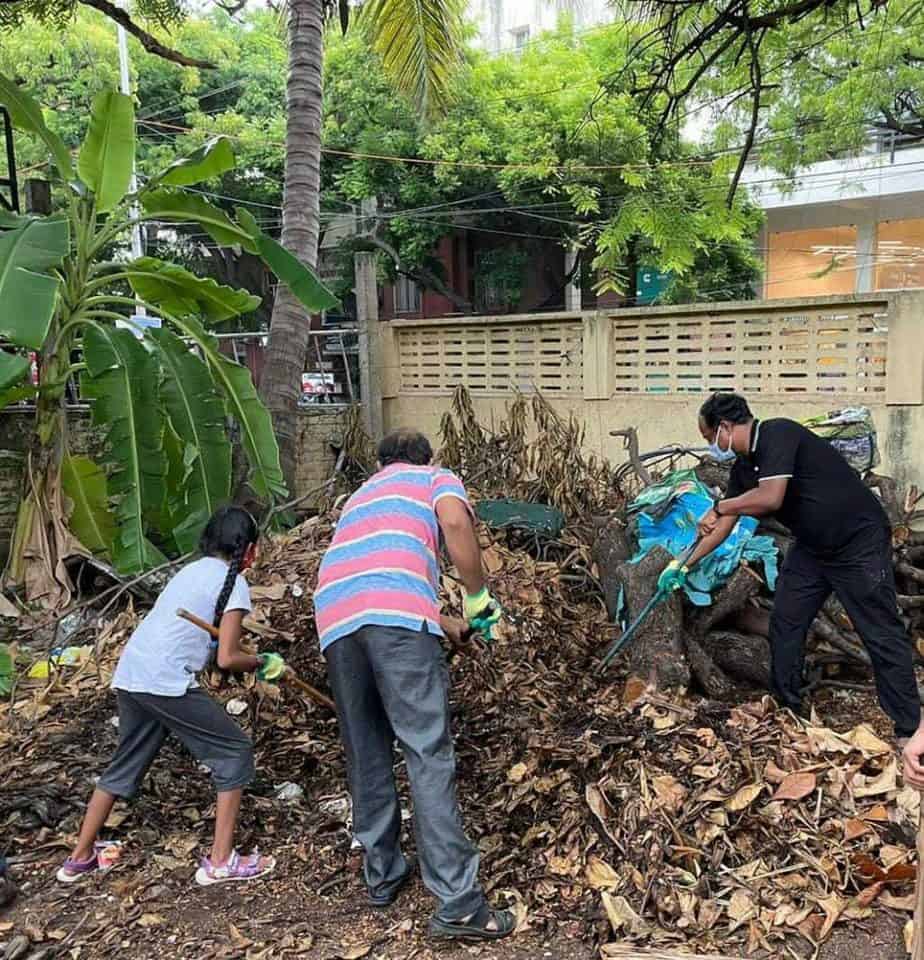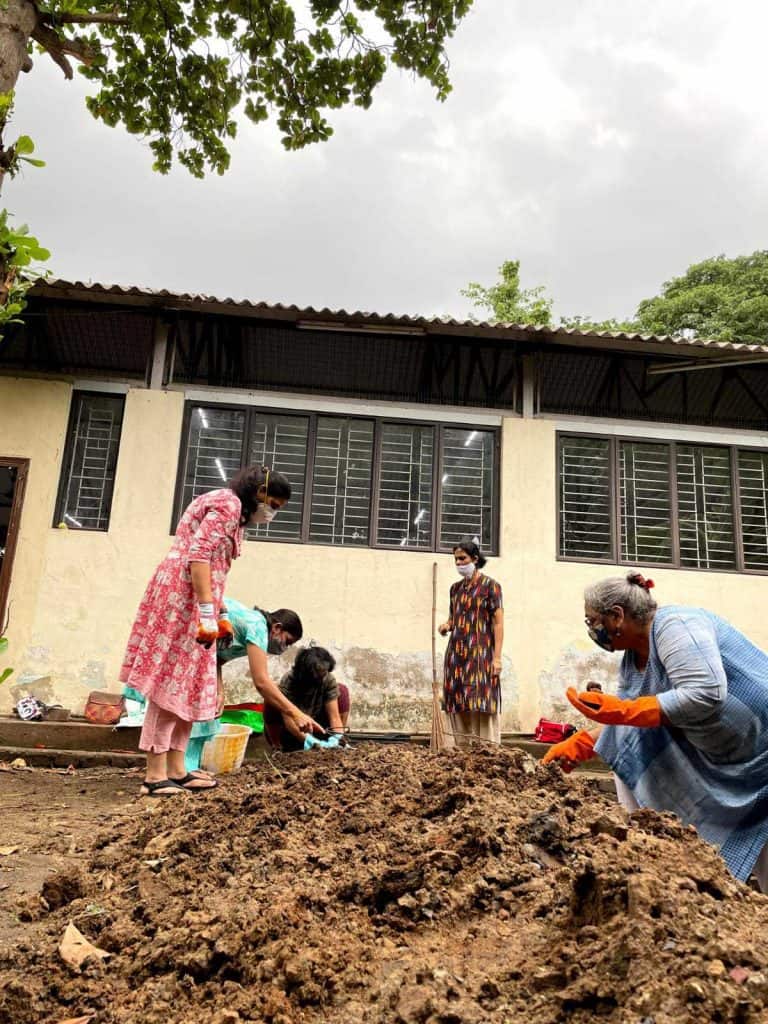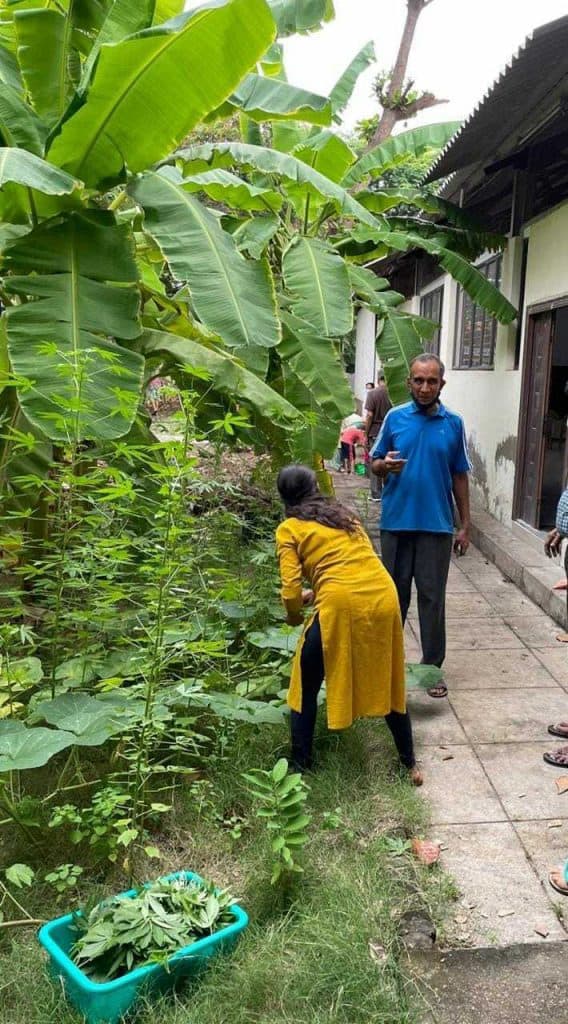Can you think of a shared garden space in the city where you plan along with your neighbours to grow local produce in a sustainable way? Imagine such a space in the heart of the city that affords opportunities to learn and share your knowledge, while simultaneously welcoming the young and old alike to relax and connect with nature. The month old community garden in Kasturba Nagar serves as all this and more for the residents who have banded together to create a green space in their locality.
Citizen Matters spoke with Samyuktha Kannan, one of the members behind the community garden effort to learn more. Here are excerpts from the interview:
Community garden takes shape
What is the concept behind a community garden? What led to the launch of this particular one at Kasturba Nagar?
A community garden is primarily a shared space. It can be on public or on private land. It can even be in an apartment. But the idea is that this shared space is collectively cultivated by a group of volunteers who come together just for the purpose of learning and enjoying gardening. So that’s the idea.
How did you first come across community gardens and want to start one in Chennai?
I first came across the concept when I was studying in the US. I studied at a university that really prioritized community living as a culture. There was a community garden, where I used to go as a student and volunteer, and I learned a lot through that experience. That’s how I came across the concept. Apparently, it is quite a popular concept in cities across the world.
Community gardens can be basically what the volunteers decide or want it to be. So it can have a common theme, or you can have the entire land cultivated together by people or divided into sub plots with each plot cultivated by groups. So it varies by design. But it is a democratic process.
In general, I thought it would be particularly relevant in India, because we live in very crowded spaces. It’s hard to come by instances where people can get down on the ground and feel the soil and actually do some gardening. People’s response to the lack of space and greenery has generally been to have private gardens like terrace gardens, balcony gardens and the like. But the downside is that it requires extensive resources and a lot of time. Not everybody can afford to maintain a garden of their own. So I thought it would be good to have a community garden — this garden is designed to be a kind of place where people, even with limited resources, can come in and learn gardening, enjoy its benefits. It began as an experiment and let us see how it goes here.
Read more: Greening rooftops: 10 ideas from Chennaiites
How did you zero in on a space for the community garden and get people to rally around the idea?
I’m fortunate to live in a locality where the residents’ welfare associations are pretty active. There are already a lot of people in the locality who have been involved in civic issues and in waste segregation and particularly in greening. They have also been closely interacting with the corporation and local government. When this idea was first suggested, people were quite receptive.
I’d actually first initiated this idea a couple of years ago. I had some doubts about finding a suitable space. This was when we noticed that the community hall in the locality had some open space around it. This hall is meant for use by residents for community activities and you can also hire it for private use. But the open area around the hall was rather unkempt. Surrounding houses and commercial establishments were using it to dump their garbage. And yet, we observed that the space had a lot of open soil and good sunlight, making it perfect for gardening. With the help of the RWA we were able to get permission to use the space for this purpose.
A couple of years ago, before COVID-19 struck, we made the first attempt at one of the community events. I spoke about the idea and a few people came forward to volunteer. But there were a lot of hurdles at the time. Many issues came up, such as the effect of the garbage on the soil. We also had huge pest problems. We ran into many practical challenges and as we were mostly trial-and-error gardeners, we couldn’t put out fires soon enough. So it just wasn’t sustainable.
How are things different this time?
This time around, residents have a little more experience with urban gardening, having experimented with it at home during the lockdowns. We found that we have more like-minded residents now, who are invested in the idea. When talk of the community garden came up in conversation, a few people expressed keen interest in it.
I have also tweaked the concept a little bit to focus not only on the garden, but also on learning events around it. The idea is to make it a platform where people who are gardening in their own homes can share their knowledge and experience and learn from each other.
The working of a community garden
How are decisions made in running the community garden?
We have a couple of resource people on board now. These are people who are experienced farmers and gardeners themselves. We sat with them first and went over the basic infrastructure requirements for guidance.
It was not simple, as we had a number of things to consider. Having these resource people really helped us get the groundwork in place. After that, once all the volunteers came on board, we had a brief session at the very outset, where we discussed the basics; this gave everybody an idea of what could happen and thus set the expectations.
We also had a little exercise where I asked everybody to look at the space and use it as an opportunity to envision what that space could be. What was their vision for it? Without this kind of a vision for a garden, the daily activities can become a little tedious. While gardening in itself is a rewarding activity, there are many people for whom this might appear a mundane activity in the initial stages unless there is an end goal in sight. With a garden, as with nature, you have to be a little patient. So I think that exercise was important.
A lot of people had really great suggestions for what we could do there and the kind of crops that we could grow. Someone suggested creating a place to grow mushrooms, someone else suggested having a mini apiary, because providing a home for pollinator bees does not just help the garden, but also helps the entire neighborhood. There were also inputs on growing native greens. Now we are collectively planning a layout based on what everyone has suggested.
At present, what are the day to day activities at the garden?
We have weekly gardening sessions. Every Saturday evening, we open it up and have a bunch of activities that we plan, or do all the things that need to be done in the garden. We try to keep a mix of activities, so as to accommodate people with different interests. At these sessions, a lot of people show up. It is open for anybody who wants to come in and help out.
On a day to day basis, there are three or four dedicated volunteers who look into and execute the details of garden management.
In my experience, from other community gardens that I’ve seen, I think this is the kind of model followed widely. There are a few people who live close by, who have the interest and the time to do the regular work. They hold things together and then volunteers are welcome to join at the weekly sessions.
How did you share the costs of setting up the garden?
People who have been participating in the garden and in our learning events have all been contributing small amounts. We’ve been raising funds from those who are interested in supporting the garden. So far, we’ve been working within our means. We’ve been trying to make maximum use of the resources that are just available out there.
It’s been very helpful to have a few resource people who have done this before. People who have experience with organic farming have helped keep it low cost. So it’s not as expensive as it would be, if you were just buying all of your planting materials. I think this is something that has also been important for us, for me personally, in terms of the learning we’ve had. Other volunteers have also said that they found it really helpful to learn how to restore soil and everything on their own by using local resources, instead of having to buy soil and to buy nutrients.
Eventually, however, for the garden to become better there will be a need for more resources, more manpower and more funds. So we’re looking to now raise funds from local businesses and seek support from the local government. Hopefully, we will find more people who are interested in supporting the garden.
There are a few things that we have in the pipeline: both towards fundraising and organizing some interesting reasons for people to come together to learn about gardening.
How do you share the produce from the garden?
In a community garden, usually the main purpose is to come together to do the gardening and the harvest is also shared by the volunteers. The joy lies in the fact that you are part of the community and producing things that you can take fresh off the garden and are able to eat. So, that’s the idea for the harvest.
Takeaways and challenges
What have been some key learnings from the initiative?
We are quite new, the garden being only around a month old. The success for me at this point is the amount of knowledge sharing that has happened within the group. People have shared pictures of challenges that they’ve been struggling with — it could be a problem with a pest or with growing something — and so many others have come forward to help with suggestions and inputs based on what they know from experience.
Another nice thing is the fact that we’ve been getting people of all ages to come to the garden. There are people who are bringing along their kids, or elderly family members who have been coming and helping in whatever way they can. It’s nice to see a community work together. People have been very forthcoming in terms of sharing their contacts and everything.
What have been some of your biggest challenges?
We have had some practical challenges, and I also foresee some of the same challenges that we faced when we tried a couple of years ago; we haven’t been pursuing this long enough now to know whether these are going to repeat themselves or not.
The most worrying fact is that there is so much plastic everywhere. As we try to cultivate this garden, we just keep coming up against plastic — in the soil, in the leaves and in nearby areas where people are constantly throwing plastic. Much of the plastic accumulated over the years has been covered with layers of soil now. So now it’s almost a part of the soil. As we dig, and try to clean up the area to grow plants, it’s heartbreaking to see how much plastic there is beneath our feet. This is actually holding up some of our garden activities. We’ve been trying to clean it up for a really long time now.
The other challenge is finding people who are selflessly interested in just doing the gardening work, because one has to be patient with it and cannot expect quick rewards. It always helps if you have an inherent liking for gardening — if you like being outdoors, being with nature. This is something that we hope that kids who are joining us will develop at a young age.
There’s always something interesting. You spot a new bug or or find a beautiful butterfly and that’s what you have to look forward to, instead of feeling, ‘Oh, it’s been a month and we haven’t got any tomatoes yet’. That’s definitely not the point of a community garden. I hope we shall be able to foster this in our own communities in time.
If residents of other localities in Chennai want to start something like this, what would your message to them be?
I think every community and every neighbourhood should definitely strive to have a community garden. There have been many studies to show how this can help neighbourhoods come together. It’s not just gardening. Of course, it is beneficial for your local environment, especially when you don’t have any other park or open space. These spaces provide a wonderful home for all the small creatures that are around us. So, the garden nurtures biodiversity in the neighbourhood.
But gardening as a community activity is also a bonding exercise. I have met so many people in my neighbourhood through this initiative, whom I had never met in almost 15 years. People are coming together with a shared interest and that makes for a really good experience. When you come to the garden, it refreshes your mind and also leaves you with physical benefits.
In addition, for people with limited resources, a community garden is a space to come out and experiment.
The Kasturba Nagar Community Garden welcomes volunteers from anywhere in Chennai. If you’d like to volunteer or have questions about starting a community garden in your own locality, get in touch with Samyuktha on Instagram @communitygardenchennai or Whatsapp +91 9841816131.


